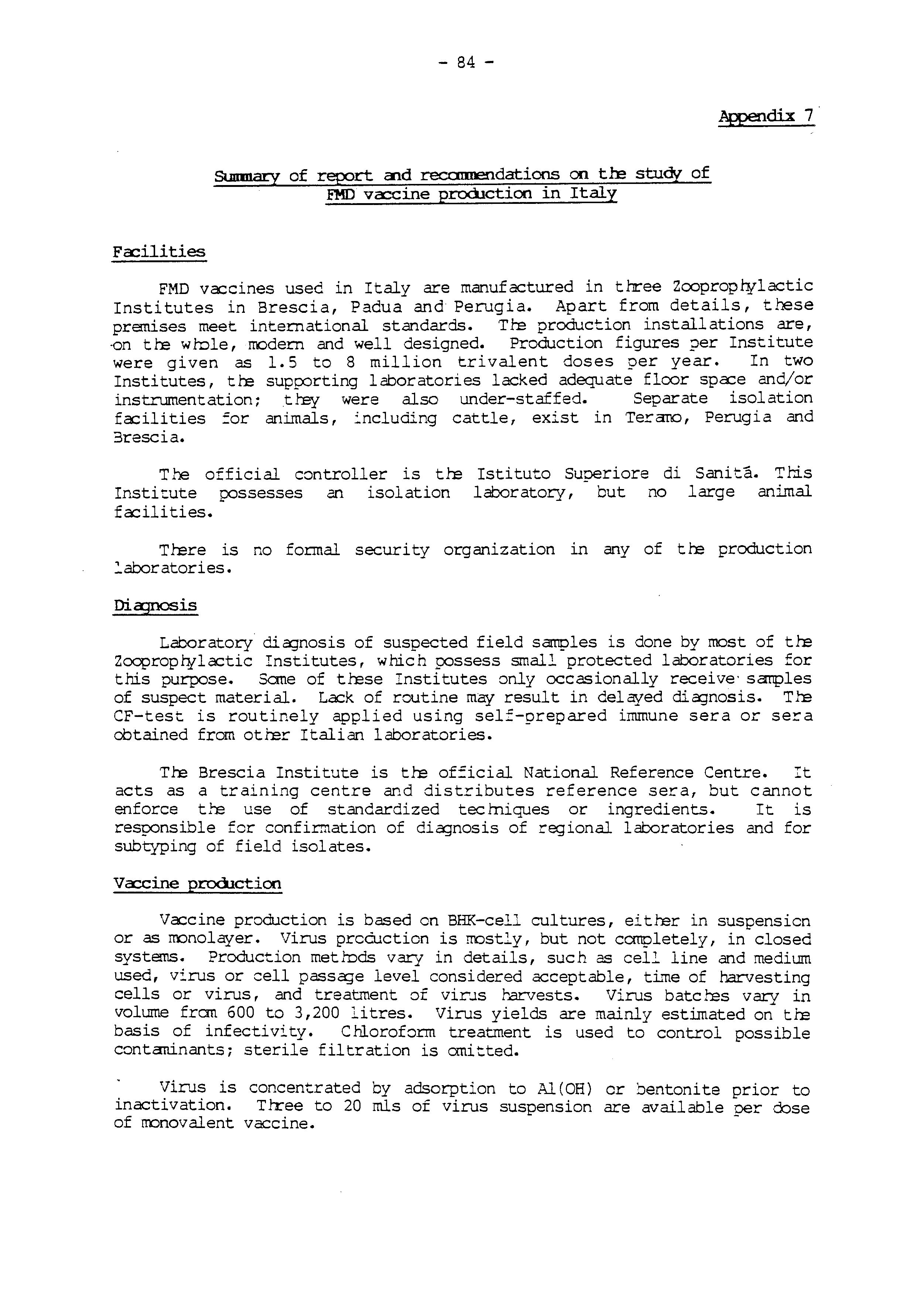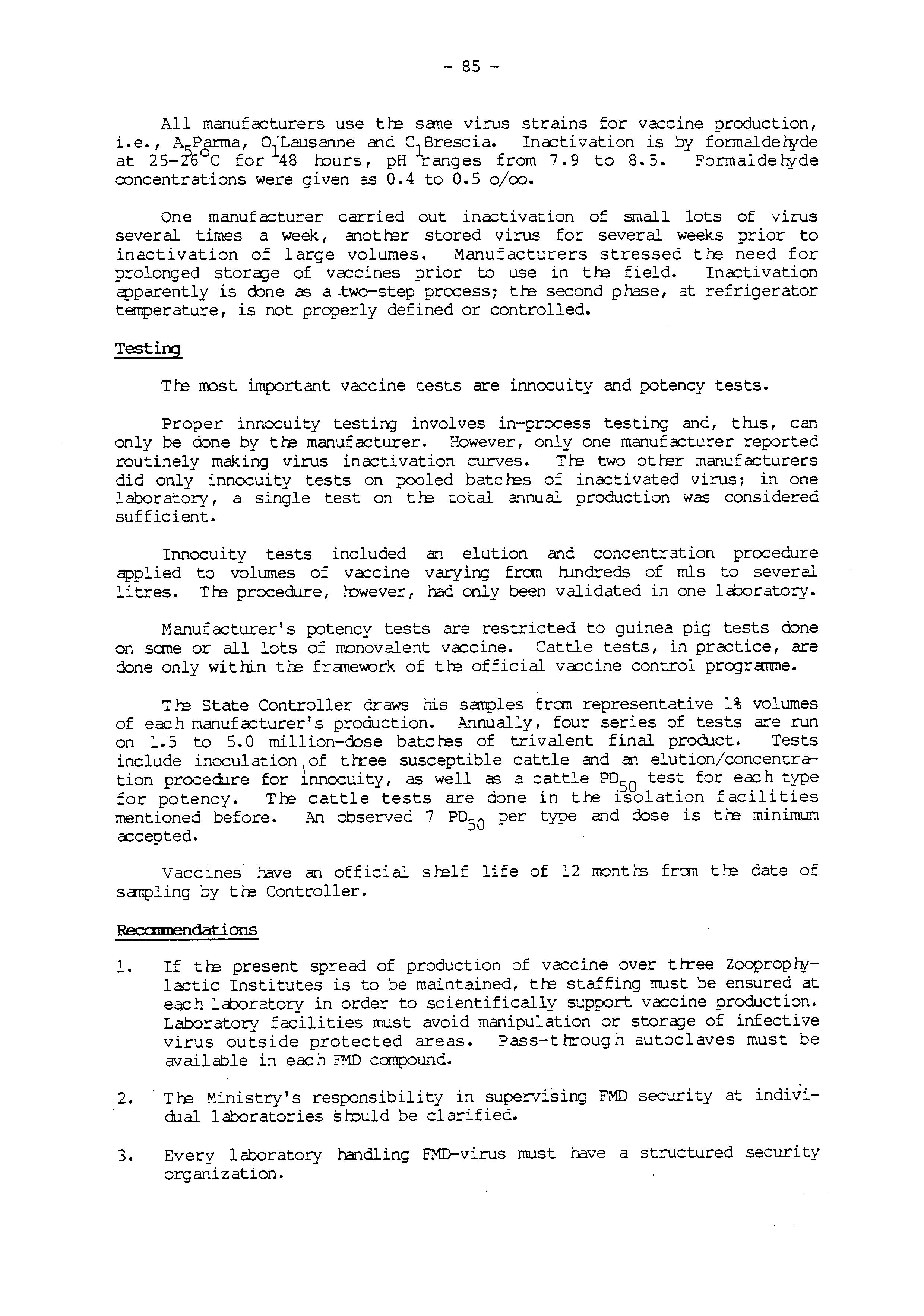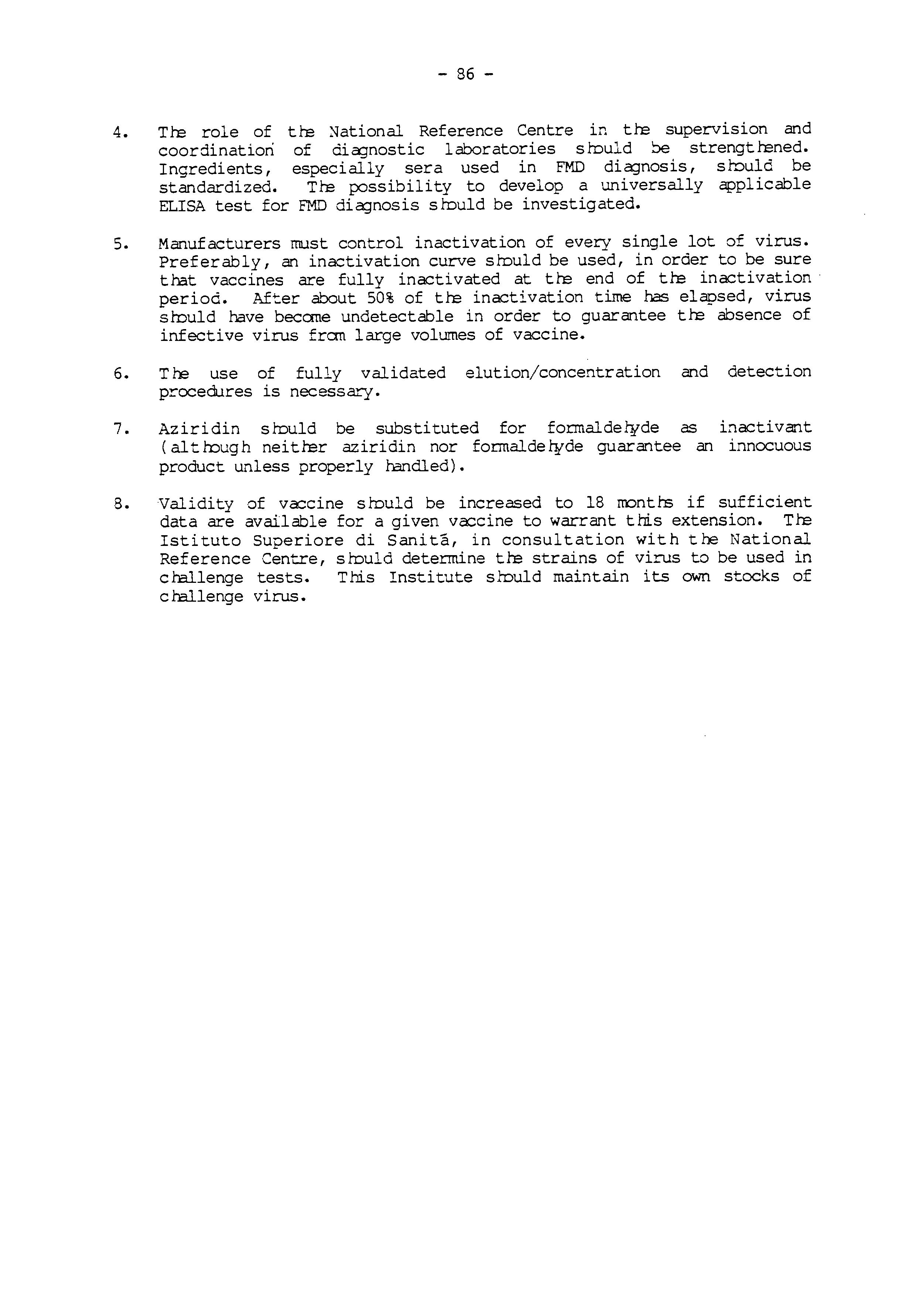
4 minute read
study of FMD vaccine production in Italy
Appendix 7.
Sumnary of rep:,rt end rec::amei.dations on the study of FMD vaccine prodlction in Italy
Advertisement
Facilities
FMD vaccines used in Italy are manufactured in three Zoopropcylactic Institutes in Brescia, Padua and Perugia. Apart from details, these premises meet international standards. Tre production installations are, -on tre wrole, rrodern and well designed. Production figures ;,er Institute were given as 1. 5 to 8 million trivalent doses per year. In two Institutes, tre supp:)rting laboratories lacked adequate floor space and/or instrumentation; trey were also under-staffed. Separate isolation facilities :or animals, ::.ncluding cattle, exist in Terano, Perugia and 3rescia.
The official controller is tre Istituto Superiore di Sanita. This Institute p:)SSesses an isolation laboratory, but no large animal facilities.
Trere is no fo:r::mal security organization in any of tre production :abor atori es.
Dicgnosis
Laboratory diagnosis of suspected field samples is done by most of tte Zoopropcylactic Institutes, which possess small protected laboratories :for this purpose. Sane of trese Institutes only occasionally receive· sanples of suspect material. Lack of routine may result in delayed diagnosis. Tre CF-test is routinely applied using self-prepared immune sera or sera obtained from otter Italian laboratories.
Tre Brescia Institute is tte official National Reference Centre. It acts as a training centre and distributes reference sera, but cannot enforce tl-:e use of standardized tech1iques or ingredients. It is responsible for confirmation of diagnosis of regional laboratories and for subtyping of field isolates.
Vaccine prodJ.ction
Vaccine production is based on BHK-cell cultures, eitrer in suspension or as rronolayer. Virus prccuction is rrostly, but not canpletely, in closed systems. Production metmds vary in details, such as cell line and medium used, virus or cell passage level considered acceptable, tL~e of harvesting cells or virus, and treatment of vir..1s r.arvests. Virus bate.res vary in volume fran 600 to 3,200 litres. Virus yields are mainly estimated on tte basis of infectivity. Chloroform treatment is used to control possible contaninants; sterile filtration is anitted.
Virus is concentrated by adsorption to Al (OH) or bentoni te prior to inactivation. Trree to 20 mls of virus suspension are available per cbse of m:::,novalent vaccine.
All manufacturers use the sane virus strains for vaccine production, i.e., A5P~a, OiLausanne and c1 Brescia. Inactivation is at 25-Z6 C for 48 tours, pH ranges from 7. 9 to 8. 5. by formaldelyde Formal de 1¥de concentrations were given as 0.4 to 0.5 0/00.
One manufacturer carried out inactivation of small lots of virus several times a week, another stored virus for several weeks prior to inactivation of large volumes. Manufacturers stressed tre need for prolonged storage of vaccines prior to use in the field. Inactivation apparently is done as a.two-step process; the second phase, at refrigerator temperature, is not properly defined or controlled.
Testirg
The rrost important vaccine tests are innocuity and potency tests.
Proper innocuity testing involves in-process testing and, tlus, can only be done by the manufacturer. However, only one manufacturer reported routinely making virus inactivation curves. The two other manufacturers did only innocuity tests on pooled batches of inactivated virus; in one laboratory, a single test on tte total annual production was considered sufficient.
Innocuity tests included an elution a~d concentration procedure applied to volumes of vaccine varying £rem h.mdreds of rnls to several litres. The procedure, rowever, ha.d only been validated in one laboratory.
Manufacturer's potency tests are restricted to guinea pig tests done on sane or all lots of monovalent vaccine. Cattle tests, in practice, are done only within tte franew:)rk of tte official vaccine control prcgranme.

T re State Controller draws his s21111ples £ran representative 1 % volumes of each manufacturer's production. Annually, four series of tests are run on 1. 5 to 5. 0 million-dose bate res of trivalent final product. Tests include inoculation\ of tlree susceptible cattle and an elution/concentration procedure for potency. for innocuity, as well Tre cattle tests are as a done cattle PD50 test for each type in tre isolation facilities mentioned a::cepted. before. An observed 7 PD50 per type and dose is tte :ninimum
Vaccines have an official stelf life of 12 m:mti:E fran tte date of sar.pling by tre Controller.
Recamendations
1. If tre present spread of production of vaccine ove:r tlree Zooproprylactic Institutes is to be maintained, tre staffing rrust be ensured at each laboratory in order to scientifically support vaccine production. Laboratory facilities must avoid manipulation or storage of infective virus outside protected areas. Pass-through autoclaves must be available in each FMD ccmpound.
2, Too Ministry's responsibility in supervising FMD security at individ.lal laboratories srnuld be clarified.
3. Every laboratory handling FMD-virus must have a structured security organization.
4. Tre role of tre National Reference Centre in tte supervision and coordination of dia;rnostic laboratories srould '::>e strengtrened.
Ingredients, especially sera used in FMD dia;rnosis, srould be standardized. Tre possibility to develop a universally applicable ELISA test for FMD dia;rnosis srould be investigated.
5. Manufacturers must control inactivation of every single lot of virus.
Preferably, an inactivation curve srould be used, in order to be sure that vaccines are fully inactivated at tte end of tre inactivation · period. After about 50% of tre inactivation time has elapsed, virus sl'Duld have becane undetectable in order to guarantee tre absence of infective virus fran large volumes of vaccine.
6. The use of fully validated elution/concentration and detection procedures is necessa...ry.
7. Aziridin srould be substituted for forrnaldelyde as inactivant ( al trough neitrer aziridin nor forrnaldelyde guarantee an innocuous product unless properly h:mdled).
8. Validity of voccine srould be increased to 18 nontrs if sufficient data are available for a given voccine to warrant this extension. Tre
Istituto Superiore di Sanita, in consultation with the National
Reference Centre, srould determine tr:e strains of virus to be used in crallenge tests. This Institute sl-ould maintain its own stocks of c rallenge virus.











